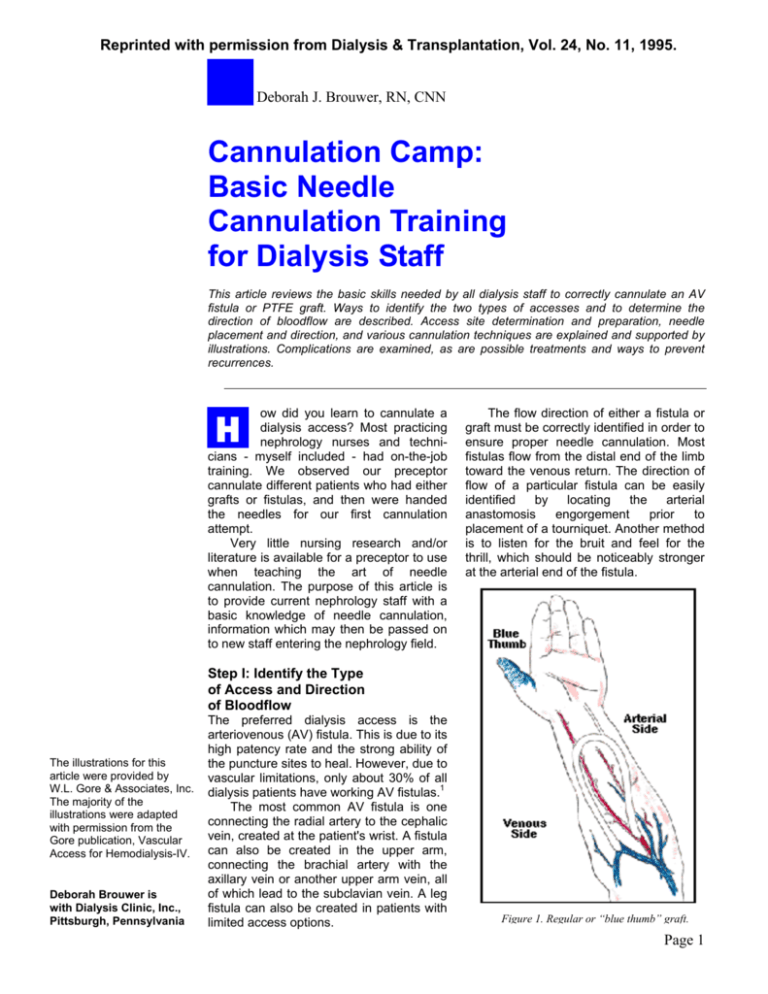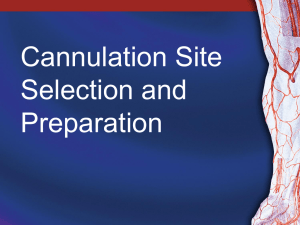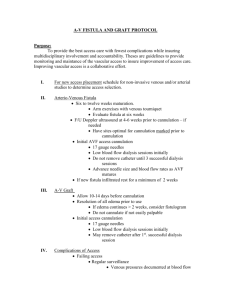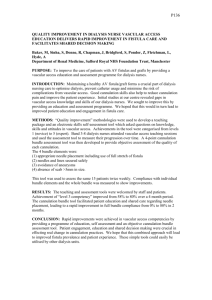Cannulation Camp
advertisement

Reprinted with permission from Dialysis & Transplantation, Vol. 24, No. 11, 1995. Deborah J. Brouwer, RN, CNN Cannulation Camp: Basic Needle Cannulation Training for Dialysis Staff This article reviews the basic skills needed by all dialysis staff to correctly cannulate an AV fistula or PTFE graft. Ways to identify the two types of accesses and to determine the direction of bloodflow are described. Access site determination and preparation, needle placement and direction, and various cannulation techniques are explained and supported by illustrations. Complications are examined, as are possible treatments and ways to prevent recurrences. H ow did you learn to cannulate a dialysis access? Most practicing nephrology nurses and technicians - myself included - had on-the-job training. We observed our preceptor cannulate different patients who had either grafts or fistulas, and then were handed the needles for our first cannulation attempt. Very little nursing research and/or literature is available for a preceptor to use when teaching the art of needle cannulation. The purpose of this article is to provide current nephrology staff with a basic knowledge of needle cannulation, information which may then be passed on to new staff entering the nephrology field. The flow direction of either a fistula or graft must be correctly identified in order to ensure proper needle cannulation. Most fistulas flow from the distal end of the limb toward the venous return. The direction of flow of a particular fistula can be easily identified by locating the arterial anastomosis engorgement prior to placement of a tourniquet. Another method is to listen for the bruit and feel for the thrill, which should be noticeably stronger at the arterial end of the fistula. Step I: Identify the Type of Access and Direction of Bloodflow The illustrations for this article were provided by W.L. Gore & Associates, Inc. The majority of the illustrations were adapted with permission from the Gore publication, Vascular Access for Hemodialysis-IV. Deborah Brouwer is with Dialysis Clinic, Inc., Pittsburgh, Pennsylvania The preferred dialysis access is the arteriovenous (AV) fistula. This is due to its high patency rate and the strong ability of the puncture sites to heal. However, due to vascular limitations, only about 30% of all dialysis patients have working AV fistulas.1 The most common AV fistula is one connecting the radial artery to the cephalic vein, created at the patient's wrist. A fistula can also be created in the upper arm, connecting the brachial artery with the axillary vein or another upper arm vein, all of which lead to the subclavian vein. A leg fistula can also be created in patients with limited access options. Figure 1. Regular or “blue thumb” graft. Page 1 Reprinted with permission from Dialysis & Transplantation, Vol. 24, No. 11, 1995. Cannulation Camp Unfortunately, the flow direction within an implanted polytetrafluoroethylene (PTFE) graft cannot be so easily identified. This is because a graft can be placed in any location where an artery and vein can be connected. The traditional graft sites - i.e., the lower arm (loop graft) and upper arm (straight graft) - have now been supplemented by straight or loop grafts in the leg, groin, abdomen, chest, or neck. As such, the direction of the bloodflow may not be apparent by visual inspection alone. Cooperation with the vascular surgeon in obtaining a drawing or description of the bloodflow direction is the best way to ensure proper use of the access. In the absence of such records, several techniques can be used to determine bloodflow direction. As previously mentioned, the most commonly used technique is to listen to the bruit and feel for the thrill at both ends of the graft; the end with the stronger bruit and thrill is assumed to be the arterial limb. To confirm this assumption, the mid-graft area can be lightly compressed to impede the bloodflow; again, the end with the Figure 2. Reversed or “red thumb” graft. stronger bruit and thrill can be considered to be the arterial limb. Next, the graft can be cannulated with two needles and the blood flashback observed. When the mid-graft area is compressed, the arterial needle flashback should remain visible, while the venous needle flashback should greatly diminish or disappear. If a graft is to be used prior to the clearance of all residual operative edema, it may be difficult to palpate the graft or to compress the mid-graft segment in order to show a difference in blood flashback within the arterial and venous needles. In this case, noting the venous pressure and pre-pump arterial pressure may assist in determining the bloodflow direction. To accomplish this, the needles are connected to the dialysis circuit, a 200 ml/min bloodflow is achieved, and the mid-graft region is lightly compressed. If the needles have been correctly connected arterial-to-arterial and venous-to-venous, the venous pressure will fall due to the decrease in bloodflow to the venous limb when the mid-graft region is compressed. If the arterial bloodline has been incorrectly connected to the needle in the venous limb of the graft and the venous bloodline to the needle in the arterial limb, the pre-pump arterial pressure will change to a more negative number and the venous pressure will increase. This is a result of the mid-graft compression causing the arterial bloodline connected to the venous limb of the graft to work harder in order to receive the inflowing blood; the venous pressure increases due to the compression of the venous outflow track. If this occurs, the bloodlines should be reversed, the mid-graft compression repeated, and a fall in the venous pressure should then be observed.2 Once the direction of the bloodflow is determined, the patient's chart should be marked Figure 3. Direction of bloodflow determines needle placement. with the flow direction. In this regard, grafts can be described as being either a regular or "blue thumb" graft, or a reverse or "red thumb" graft. A "blue thumb" graft is when the arterial inflow is on the limb of the graft medial to the midline of the body or heart (see Figure 1). A reverse or "red thumb" graft is one in which the arterial inflow is on the limb of the graft distal to the body midline or heart2 (see Figure 2). Of all dialysis loop grafts, approximately 80% are regular, with the remaining 20% being reverse.3 The red or blue thumb concept can be easily taught to patients so that they may understand the bloodflow direction within their own access. Figure 4. Venous needle always points toward the venous return. Arterial needle may point in either direction. Page 2 Reprinted with permission from Dialysis & Transplantation, Vol. 24, No. 11, 1995. Cannulation Camp Figure 5. Needle placement if only one portion of the graft can be used for cannulation. Step II: Needle Site Selection Since the placement and direction of the access needles can vary, needle site selection should be determined before skin preparation and needle cannulation are performed. It is the direction of the bloodflow that determines the needle placement. This is because the venous needle must always point toward the venous return. The arterial needle, on the other hand, may point in either direction (see Figures 3 and 4). The terms antegrade and retrograde are used to describe the direction of the arterial needle. Antegrade cannulation has the arterial needle pointing in the direction of the bloodflow, that is, toward the venous limb. Retrograde cannulation has the arterial needle pointing toward the arterial anastomosis.4 Either of these cannulation techniques can be used, with the choice being based on unit practice. When complications such as infection or recent surgical revision dictate that only one limb of a loop graft can be used, the needles may be placed on the same side of the graft, with one needle placed upward and the other downward, as shown in Figure 5. When that is the case, the needles must always be at least 1" apart, as measured from hub to hub, in order to prevent recirculation (see Figure 6). Care should be taken in those cases where the needles are placed in the same direction on the same limb, for if they are placed too close, such as less than 3" apart as measured from hub to hub, the needle bevels may touch or be too close and lead to recirculation2 (see Figure 7). Both antegrade and retrograde cannulation can be used with AV fistulas, as well. Antegrade cannulation can be used to cannulate near the arterial anastomosis of an access without the needles entering the anastomosis site. This is particularly helpful with newly created AV fistulas that are not fully matured, as the antegrade cannulation can sometimes provide a higher bloodflow with less bloodline collapse or line sucking, and a better pre-pump arterial pressure. Needle site placement must always take into account needle site rotation. This is true for both AV fistulas and grafts. Proper needle site rotation will extend the life span of the access by preventing pseudoaneurysm formation, or "one-site-itis" (see Figures 8 and 9). Additionally, fistulas that are cannulated throughout the entire fistula will mature more evenly, and grafts so cannulated will not develop flat, mushy areas caused by repeated cannulation in the same spots, which do not allow for fibrous tissue formation and, subsequently, lead to the development of large holes (Figure 9). A patient record of the cannulation sites-such as an illustrated bedside cannulation chart and a cannulation rating chart-can be used to help ensure full needle site rotation (see Figures 10 and 11). Step III: Skin Preparation The needle sites selected for cannulation must be properly prepped in order to prevent infection. Proper washing of the patient's access area with water and an antibacterial soap should be done prior to cannulation. If the patient is unable to wash his or her own access area, the dialysis staff can use a washcloth soaked with antibacterial soap to cleanse the area. A ready-to-use antibacterial towel or prep pad can also be used. After cleansing, the sites should then be prepped with either Betadine or alcohol. Once applied, Betadine must be allowed to dry before it is an effective antiseptic, whereas alcohol must be used in a liquid state to be effective.5 During the preparation of the access sites, universal precautions, including the wearing of gloves, must always be used to prevent the spread of infection. Step IV: Local Anesthesia If the patient experiences discomfort during cannulation, the administration of an intradermal injection of lidocaine may be used immediately prior to the needle cannulation. Other agents, such as Chloroethane (ethyl chloride) spray, or lidocaine 2.5% with prilocaine 2.5% (Emla Cream), can also be used to prevent discomfort from the cannulation. Because of the potential for further discomfort brought on by additional needle sticks, the choice of using lidocaine as a local anesthetic for needle cannulation should be at the request of the patient; however, its use should be avoided in the case of a deep or edematous graft-which may occur with newly created Page 3 Reprinted with permission from Dialysis & Transplantation, Vol. 24, No. 11, 1995. Cannulation Camp Figure 8. “One-site-itis” due to repeated needle puncture in the same location, the result of poor needle site rotation. PTFE grafts-where the injection of lidocaine prevents palpation and easy cannulation. When using lidocaine, the minimal amount (0.2 cc) should be used, and the patient should be warned that the injection might burn or sting. Care must always be taken to ensure that the lidocaine is injected only into the tissue on top of the access and never into the graft or fistula itself. to 500 ml/min are now standard in many dialysis units). Pre-pump arterial pressure monitoring can help determine if the needle gauge needs to be increased. If the arterial pressure falls lower than -200 to -250 mmHg, the needle size should be increased (i.e., a smaller gauge number should be used). However, this decision should first be discussed with the dialysis staff and the nephrologist. Step V: Needle Selection The specific gauge of the needles used for cannulation should always be ordered by the nephrologist in order to ensure that an adequate bloodflow rate is achieved for the proper delivery of the dialysis prescription. The length of the needles, on the other hand, may be altered by the dialysis staff in order to reach, for instance, deep grafts such as those found in the upper arm of an obese patient, where a 1" needle may not be long enough to cannulate the graft or advance far enough into the graft to prevent movement. In that case, a 1 1/4" needle may be helpful. The needles used should always have a back eye to ensure that the optimal flow is achieved. Additionally, the standard 16-gauge needle may need to be increased to a 15- or 14-gauge in order to achieve bloodflows greater than 300 ml/min (bloodflow rates of 350 Step VI: Cannulation Technique The needle should be held by the wings, with the bevel of the needle facing upward for the cannulation (see Figure 12). This places the cutting edge of the needle on the skin, which facilitates cannulation through the skin, subcutaneous tissue, and the graft wall or fistula vessel wall. The needle should be held at a 20- to 35-degree angle for AV fistulas, and at approximately a 45degree angle for grafts.6 Once the needle has been advanced through the skin, subcutaneous tissue, and graft or fistula wall, the blood flashback should be visible. Continue to advance the needle no greater than 1/8 of an inch and then rotate the needle 180 degrees6 (see Figure 13). The needle bevel is rotated to help prevent a "back wall" or posterior wall infiltration, which can occur if the needle's bevel tip accidentally punctures the bottom of the graft or fistula (see the discussion under "Cannulation Problem-Solving"). The needle should then be leveled out (i.e., placed flat against the skin) and then advanced slowly up to the needle hub (see Figure 14). Step VII: Securing the Needle The wings of the fistula needle can be secured by using a butterfly tape technique. A piece of 1"-wide adhesive tape 6" or greater in length is carefully placed under the fistula needle wings and then folded so that it crosses over the or Figure 9. A pseudoaneurysm caused by “one-site-itis,” which can lead to graft failure. Page 4 Reprinted with permission from Dialysis & Transplantation, Vol. 24, No. 11, 1995. Cannulation Camp procedure, a 2x2 gauze pad may be placed under the needle wings to correct the needle angle. Care must be taken with any change to the needle position so that infiltration into the back or side wall of the graft or fistula is avoided. Step VIII: Cannulation ProblemSolving Figure 10. Bedside cannulation chart, showing dates and locations of prior puncture sites. needle site. An adhesive bandage or a 2x2 gauze pad is then placed over the needle and secured by another 6"-long piece of tape. The needles must be secured in place in order to prevent accidental dislodgment or movement of the needles within the access, and care must be taken to monitor the needles for inadvertent movement during the dialysis treatment. This movement within the graft or fistula can result from the patient rotating or bending his or her access limb, which may lead to poor bloodflow and/or needle infiltration. Special care must be taken with deep or edematous grafts because the needles are more prone to shift after the cannulation. With edematous grafts, this results from the edema being displaced following the application of pressure during the palpation and cannulation of the graft, with the edema subsequently returning to the subcutaneous tissue surrounding the cannulation sites and causing the movement of the needles. With deep grafts, movement can occur simply because of the amount of tissue pressing against the needle. Should any movement of the needles occur during the dialysis If resistance is felt at any time during needle advance-ment or needle position change, the needle should be pulled back and the angle redirected. When in doubt, always ask a colleague for help. A back or side wall infiltration can occur with any needle cannulation. If an infiltration does occur prior to the patient receiving heparin, the needle should be pulled out and digital pressure applied to the exit site by placing two fingers along the accessextending over a minimum of a 1" span-in the area of the infiltration. Unfortunately, it is difficult to control back or side wall bleeding because direct pressure to the puncture site is not possible. If the patient has already received heparin, the infiltration site must be carefully assessed to see if the needle should be pulled out or left in place with ice applied over the site until the dialysis treatment is completed. If the infiltration site remains stable with no increase in the size of the hematoma, the needle can be safely left in place and pulled out at the end of the treatment. If, however, the hematoma increases in size, the needle should be removed and digital pressure applied. Never apply pressure to an infiltration site while the needle is still in the vessel, as this could cause further damage to the vessel wall. Should an infiltration occur, cannulation with another needle should be performed at a spot as far away from the infiltration site as possible. If the infiltration has been caused by a venous needle, the second needle should be placed above the infiltration site. However, this is not always possible, and if the venous needle must be placed below the infiltration site, it should be placed 1 1/2" to 2" away from the site to prevent the needle tip from dislodging the clot formation at the site of the vessel wall infiltration. Following the second cannulation, careful flushing of the venous needle, along with a slow restart of the dialysis blood pump, should be performed in order to monitor the infiltration site for an increase in hematoma size. Care must be taken with all needle cannulations in order to prevent infiltrations. A severe infiltration, such as a posterior or back wall infiltration in a PTFE graft, can lead to the formation of a large hematoma and subsequent graft compression and/or graft thrombosis. While the use of the 180-degree needle rotation, or "flip," discussed earlier is not necessary to correctly cannulate a PTFE graft or fistula, it may help decrease the chance of a severe infiltration. When training new staff, Page 5 Reprinted with permission from Dialysis & Transplantation, Vol. 24, No. 11, 1995. Cannulation Camp this technique may be particularly helpful in preventing the staff member from advancing the needle into and through the vessel in one smooth, uncontrolled movement. In a recent article by Hartigan,4 the question is raised as to whether flipping the needle may, in fact, actually cause additional trauma to the intimal of the access. However, Hartigan acknowledges that no controlled studies have been performed to address the risks and benefits of flipping or not flipping the needle during cannulation. Dialysis staff, therefore, should evaluate the infiltration problems that occur within their own practice and appropriately adjust cannulation techniques in order to decrease the number of infiltrations. Step IX: Removal of the Needles Proper needle removal is as important as is proper needle cannulation, for if the needles are improperly removed, damage to the vessel wall can occur, whether with PTFE grafts or AV fistulas. The tape should be carefully removed post-dialysis to prevent movement of the needles. Each needle is then withdrawn slowly, at a 20-degree angle, until the entire needle has been removed. To prevent damage to the vessel wall, digital pressure should not be applied during needle removal.6 If the needle bevel has been rotated 180 degrees during insertion, there is no clinical evidence or research that supports the re-flip or rerotation of the needle before it is withdrawn. Once the needle has been removed, mild digital pressure should be applied to the needle exit sites of both the skin and graft or vessel wall (see Figure 15). A gauze pad should be held over the sites with constant pressure, without peeking, for 10 to 15 minutes. To ensure that both the skin and vessel needle exit sites are being compressed, the patient should place both the index and middle fingers over the gauze pad, with the thumb wrapped around the limb like a "C" clamp. This will keep the patient from shifting the compression off of the exit sites, which would permit bleeding. The bruit and thrill should continue to be discernible above and below the compression sites, an indication that bloodflow occlusion (which could possibly cause thrombosis of the access) has been averted. A family member can be trained to assist patients who are unable to maintain compression of their own needle sites. When using topical clotting agents, care must be taken to ensure that the cannulation site has clotted and not just the needle exit site of the skin, for if hemostasis is not achieved, blood may leak out into the subcutaneous tissue surrounding the graft. This often happens when the patient stands up to exit the dialysis unit, at which time the cannulation site can begin re-bleeding if the clot over the skin puncture site is dislodged. If rebleeding is not visible from the skin puncture site but has occurred subcutaneously, ecchymotic areas will be present when the patient returns for his or her next dialysis treatment. Step X: Discharge Dressing and Assessment Always discharge the patient from the unit with an adhesive bandage or gauze pad over the cannulation sites. Tape may be used to secure the pad but should not be so tight that it compresses the lumen of the access. Before the patient leaves the unit, assess and document the quality of the bruit and thrill. If the bruit or thrill is greatly decreased or absent, the patient must not be discharged until the nephrologist has been notified. And remember, a Doppler-positive bruit does not Page 6 Reprinted with permission from Dialysis & Transplantation, Vol. 24, No. 11, 1995. Cannulation Camp always equate with a positive bruit and thrill. CONCLUSION Nursing research is needed to better evaluate all cannulation procedures. Our goal should be to safely cannulate any access without causing unnecessary damage to the patient's lifeline. As such, the basics of needle cannulation must be openly discussed among all patient care staff members. We must work toward having all dialysis staff members understand and master the basics of vascular access. The fundamental principles of vascular access should be used to help train future dialysis staff members in order to improve the quality of care that future dialysis patients will receive. We must continue to gain knowledge in this important area through nursing research and education. . References 1. Fan PY, Schwab S. Vascular access: Concepts for the 1990s. J Am Soc Nephrol 3:1, 1992. 2. Brouwer D. Hemodialysis: A Nursing Perspective. In: Vascular Access for Hemodialysis - IV (a W.L. Gore publication). Henry M, Ferguson R (eds.). Chicago, IL: W.L. Gore & Associates, Inc., and Precept Press, 1992. 3. Raja RM. Vascular access for hemodialysis. In: Handbook of Dialysis. Daugirdas JT, Ing TS (eds.). Boston, MA: Little, Brown & Co., 1994. 4. Hartigan M. Vascular access and nephrology nursing practice: Existing views and rationales for change. Advances in Renal Replacement Therapy 1(2):156-157, 1994. 5. Perkins JJ. Principles and Methods of Sterilization in Health Sciences (2nd Ed.). Springfield, IL: Charles C. Thomas Publishers. pp. 337-338, 1969. 6. Lancaster LE. Core Curriculum of Nephrology Nursing. Pitman, NJ: American Nephrology Nurses' Association, pp. 266, 272, 1995 Page 7




